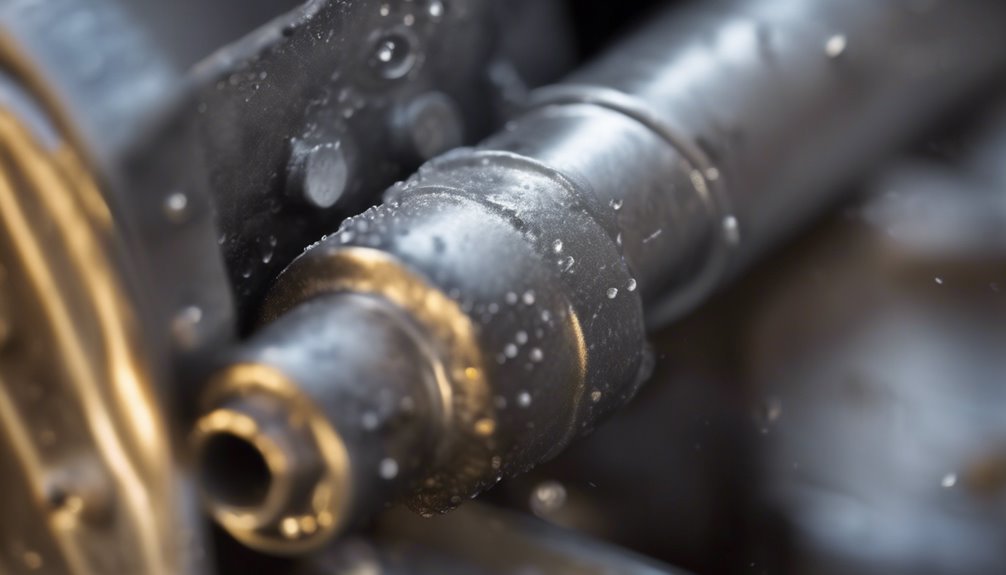
When it comes to the drive shaft in your vehicle, understanding lubrication is essential. The grease points, often called grease fittings, play an important role in keeping everything running smoothly. They’re positioned at key areas, like the universal joints, to reduce friction. But do you know how to identify these points and make sure they’re functioning properly? Let’s explore the types of grease points and their significance in maintaining your drive shaft’s efficiency.
Key Takeaways
- Universal joint grease fittings are located at the ends of the joints for lubrication.
- Slip yoke lubrication points are essential for maintaining flexibility in the drive shaft.
- Center bearing grease ports support the stability of the drive shaft assembly.
- Small metal grease fittings can often be found near joints or bearings for maintenance.
- Regular inspection of these grease points is crucial to prevent wear and tear.
Understanding the Drive Shaft Functionality
The drive shaft is a significant component in your vehicle’s drivetrain, transmitting power from the engine to the wheels. In this functionality overview, you’ll learn how the drive shaft connects to the transmission and differential, guaranteeing that the rotational force is efficiently delivered. It consists of sturdy materials that can withstand rotational stress and torque. As you drive, the drive shaft absorbs vibrations and maintains stability, allowing for smooth acceleration and handling. If there’s a misalignment or damage, you might notice unusual noises or vibrations, indicating a potential issue. Regular inspection of the drive shaft is essential to prevent costly repairs and secure peak performance. Understanding its role helps you appreciate your vehicle’s mechanics better.
The Importance of Lubrication
Lubrication is essential for maintaining the longevity and performance of your drive shaft. Without proper lubrication, friction can lead to wear and tear, causing potential damage and costly repairs. To keep your drive shaft in top shape, consider these lubrication techniques:
- Use high-quality grease suited for your vehicle’s specifications.
- Regularly check and refill lubrication to guarantee ideal levels.
- Follow the recommended lubrication frequency based on your vehicle’s usage and manufacturer guidelines.
What Are Grease Points?
Grease points are essential components on your drive shaft that guarantee proper lubrication and maintenance. They serve specific purposes, allowing you to keep the moving parts running smoothly. Understanding the different types of grease fittings helps you choose the right one for your needs.
Purpose of Grease Points
While you may not think about them often, grease points play an essential role in maintaining the health of a drive shaft. These small fittings guarantee that the components operate smoothly, reducing wear and tear. Understanding the grease point benefits helps you appreciate their importance:
- Prevents friction: Regular lubrication minimizes friction between moving parts, enhancing performance.
- Extends lifespan: Keeping components well-lubricated reduces the risk of damage, prolonging the life of your drive shaft.
- Improves efficiency: Proper lubrication guarantees your drive shaft operates efficiently, saving you fuel and maintenance costs.
Types of Grease Fittings
Understanding the different types of grease fittings is essential for maintaining your drive shaft effectively. Grease fittings come in various styles, each suited for specific grease types and fitting sizes. Knowing the right fitting can enhance lubrication and prolong the life of your components.
Here’s a quick overview:
| Grease Fitting Type | Grease Type | Common Fitting Sizes |
|---|---|---|
| Standard Zerk | Lithium-based | 1/8″, 1/4″ |
| Flush Face | Synthetic | 1/8″, 1/4″ |
| Angle Zerk | Heavy-duty | 1/8″, 1/4″ |
| Mini Zerk | General-purpose | 1/8″ |
| Button Head | High-viscosity | 1/4″ |
Types of Grease Points on a Drive Shaft
When it comes to drive shafts, you’ll find several key grease points that are essential for maintaining performance. Universal joint grease fittings, slip yoke lubrication points, and center bearing grease ports each play a crucial role in reducing friction and wear. Understanding these types can help you keep your drive shaft running smoothly.
Universal Joint Grease Fittings
Universal joint grease fittings play an essential role in maintaining the functionality of a drive shaft. These fittings allow you to perform vital universal joint maintenance, ensuring smooth operation and longevity. Understanding the different grease fitting types can help you keep your vehicle running smoothly.
Here are some key points to take into account:
- Location: Grease fittings are typically found at the ends of the universal joints, making them easy to access.
- Frequency: Regularly greasing these fittings prevents wear and tear, extending the life of your drive shaft.
- Tools: Having the right tools on hand, like a grease gun, makes the maintenance process quick and efficient.
Slip Yoke Lubrication Points
Slip yoke lubrication points are essential for ensuring the smooth operation of your drive shaft. These points allow you to apply grease directly to the slip yoke, which is critical for preventing wear and tear. Regular lubrication helps maintain the flexibility of the slip yoke, accommodating changes in length as the vehicle moves. Make sure you adhere to the recommended lubrication intervals to keep everything functioning efficiently. Neglecting these points can lead to increased friction, noise, and even a complete failure of the drive shaft. By checking and greasing the slip yoke at the right times, you’re investing in the longevity and performance of your vehicle’s drivetrain. Don’t overlook this important maintenance task!
Center Bearing Grease Ports
While maintaining your drive shaft, don’t forget about the center bearing grease ports, which play an important role in supporting the drive shaft and reducing vibration. Proper grease maintenance at these ports can enhance performance and extend the life of your vehicle’s components.
Here are a few key points to remember about center bearing grease ports:
- Location: They’re typically found near the center of the drive shaft, providing support and stability.
- Frequency: Regular greasing is vital; check your vehicle’s manual for recommended intervals.
- Type of Grease: Use the right grease type specified for your vehicle to guarantee ideal lubrication.
How to Identify Grease Points
Identifying grease points on a drive shaft is essential for maintaining ideal performance and longevity. Start by inspecting the drive shaft for grease fittings, which are typically small, metal fittings that allow grease to flow into the component. Look for noticeable circular or hexagonal shapes, often located near universal joints or bearings. Use a flashlight to enhance visibility in tight spots. Check your vehicle’s service manual for specific locations and grease fitting identification to guarantee you don’t miss any points. Regularly inspecting these fittings during routine drive shaft maintenance can prevent wear and tear, keeping your vehicle running smoothly. Remember, a well-greased drive shaft can greatly extend its lifespan and improve overall efficiency.
The Lubrication Process
Once you’ve located the grease points on your drive shaft, it’s time to understand the lubrication process. Proper lubrication is vital for maintaining your drive shaft’s functionality and longevity. Here are some effective lubrication techniques to take into account:
Understanding the lubrication process is essential for your drive shaft’s performance and lifespan.
- Grease application: Use a grease gun to apply the right type of grease directly to the grease points.
- Frequency: Regularly check and lubricate according to your vehicle’s maintenance schedule, typically every few thousand miles.
- Cleanliness: Make sure the grease points are clean before applying new grease to avoid contamination.
Signs of Insufficient Lubrication
When you neglect lubrication on your drive shaft, several warning signs can signal trouble ahead. One major indicator is unusual noises. If you hear grinding or squeaking sounds, it’s likely a result of insufficient lubrication. You might also notice vibrations during operation, which can indicate that components aren’t moving smoothly due to lack of grease. Additionally, if you see any signs of wear or damage on the drive shaft, that’s a clear sign of lubrication consequences. Overheating can also occur, leading to further damage if not addressed quickly. Keeping an eye out for these signs is essential for maintaining your drive shaft’s performance and longevity, so don’t ignore them. Regular lubrication checks can save you from costly repairs down the line.
Recommended Lubricants for Drive Shafts
Addressing lubrication issues is crucial, and choosing the right lubricants for your drive shaft can make all the difference. The recommended grease types guarantee peak performance and longevity. Here are some popular options to take into account:
- Lithium-based grease: Excellent for high-temperature applications and general use.
- Molybdenum disulfide grease: Ideal for heavy loads and extreme pressure situations.
- Synthetic grease: Offers superior stability and protection in varying temperatures.
Keep in mind the lubrication frequency too; regular maintenance is key to preventing wear and tear. By selecting the appropriate grease and adhering to a consistent lubrication schedule, you’ll help your drive shaft function smoothly, minimizing the risk of costly repairs down the line.
Maintenance Tips for Drive Shaft Grease Points
Maintaining your drive shaft grease points is essential for ideal performance and longevity. Regular drive shaft maintenance can prevent wear and tear, ensuring smooth operation. Start by checking the grease points every few months, especially if you use your vehicle frequently. Use proper lubrication techniques, like applying the right amount of grease, to avoid over or under-lubricating. Pay attention to any signs of excess noise or vibration, as these can indicate insufficient lubrication. Remember to clean the grease fittings before applying new grease to avoid contamination. Finally, consult your vehicle’s manual for specific recommendations regarding grease types and maintenance intervals. By staying proactive, you’ll keep your drive shaft in peak condition and extend its lifespan.





